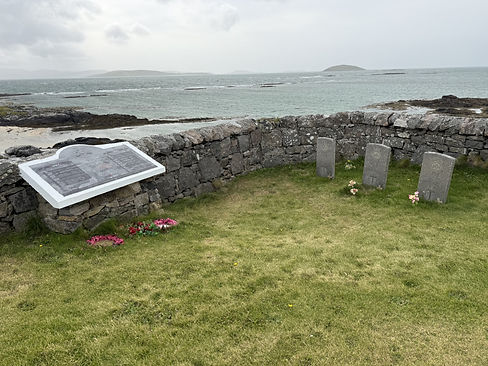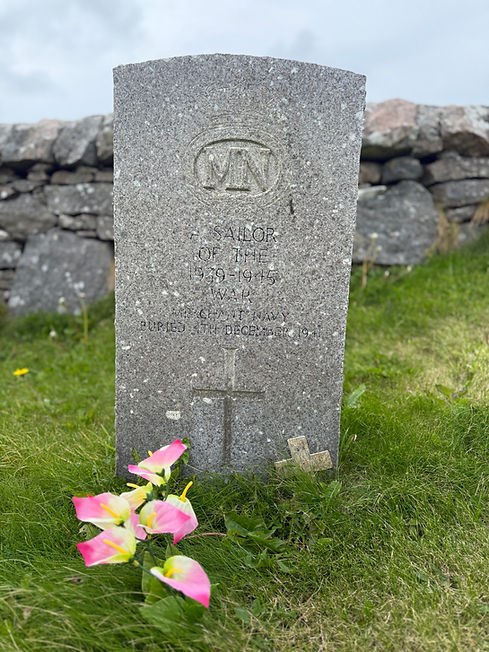
Eriskay Graveyards
Eriskay is home to two graveyards. The newer site, located at Cnoc na Sìl, has been in use since the 1950s. The first burial there was John MacMillan (Iagan Mòr) of Bun a’ Mhuilinn. The older graveyard at Rudha Chaol contains graves dating back to the 1880s. Prior to its establishment, Eriskay residents were interred at Hallin Cemetery in South Uist. Unfortunately, many of these early graves lack headstones and remain unidentified. The earliest marked grave at Rudha Chaol belongs to Archibald MacDermid, who died in July 1887 at the age of 47. A century later, in December 1987, the final burial at this site was Alexina MacKinnon (née MacInnes), aged 84, laid to rest beside her husband, Neil MacKinnon.
Research and Archives
This work is ongoing. New graves continue to be identified, contributing to a fuller understanding of the island’s history. Plans are underway to install a commemorative plaque listing the names of individuals buried in unmarked graves.
If you have information about unnamed headstones or burial locations, we warmly encourage you to get in touch. Every detail helps preserve the memory of those who came before us.
Commonwealth War Graves
The old graveyard at Rudha Chaol includes a single islander's commonwealth war grave: Private John MacRury of Acarsaid, who served in World War I. Other Eriskay men who lost their lives in both world wars are commemorated on the Comann Eachdraidh Eirisgeidh War Memorial. This quiet tribute serves as a poignant reminder that, despite its size and remoteness, Eriskay was deeply affected by the global conflicts of the 20th century.


The Unnamed War Sailors of Eriskay
In a quiet and sheltered corner of the old Eriskay Graveyard, three simple Commonwealth War Graves lie exposed to the wind and sea. Marked only by the date of burial and approximate date of drowning. “Known Unto God,” these are the final resting places of three unidentified seamen of the Merchant Navy, lost during the Second World War. Their names, ranks, and stories remain unknown. Yet the island of Eriskay has never forgotten them.
A Community’s Care
The graves are lovingly maintained. Islanders often leave flowers, and on All Souls’ Day, when the community gathers to honor those who have passed, candles are placed on every grave—including those of the unnamed sailors. Each candle is blessed by the priest, a quiet act of remembrance that ensures these men are never left out.
Small coins are sometimes found resting on their headstones—a tradition observed around the world. For known soldiers, it signals to their families that someone has visited. For the unknown, it’s a silent message: you are remembered.
Washed Ashore, Welcomed Home
Local memory tells that when the bodies of these men washed ashore, the people of Eriskay did what they could. In the absence of official procedures, they ensured a dignified burial, offered prayers, and—some believe—carefully preserved any personal effects. These items, possibly war papers, letters, photographs, or keepsakes, were said to have been sent to the families by the local priest or headteacher.
No official records survive to confirm this. But as with much of Eriskay’s history, the truth lives on in the memories of older generations, passed down through quiet conversations and community stories.
A Lasting Tribute
Though their identities remain unknown, these sailors have become part of Eriskay’s story. Their graves are not forgotten corners—they are places of reflection, gratitude, and enduring respect.

